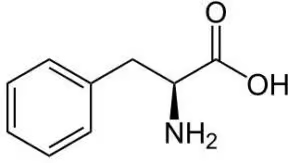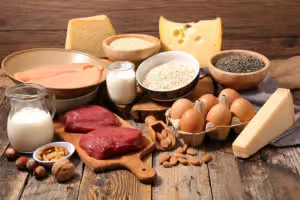Table of Contents
Phenylalanine is a highly bio-available essential amino acid. Your body naturally converts L-Phenylalanine into the amino acid L-Tyrosine which is then converted into L-DOPA. Decarboxylation of L-DOPA results in synthesis of the neurotransmitter dopamine.[i]
Once converted into dopamine, the enzyme dopamine-beta-hydroxylase converts dopamine into the neurotransmitters norepinephrine (noradrenaline) and epinephrine (adrenaline). This triad of neurotransmitters are collectively referred to as “catecholamines”.
As a nootropic supplement, you may find several different forms of Phenylalanine available. L-Phenylalanine is the natural form found in proteins. D-Phenylalanine is a mirror image of L-Phenylalanine that is made in the lab. And DL-Phenylalanine is a combination of the two forms.[ii]
L-Phenylalanine can be a highly effective nootropic for boosting cognitive function because it boosts norepinephrine and dopamine production. Resulting in increased attention, motivation and working memory.
D-Phenylalanine (but not L-Phenylalanine) has been used to treat chronic pain although the clinical research in this area is sparse.
L-Phenylalanine also stimulates the production of thyroid hormones T3 (triiodothyronine) and T4 (thyroxine) which are crucial in maintaining both overall physical and cognitive health.
Phenylalanine helps:
- Cognitive Stress. L-Phenylalanine helps produce the catecholamine-triad of neurotransmitters dopamine, norepinephrine and epinephrine. Sleep deprivation and extreme stressors like heat and cold can deplete catecholamine levels. L-Phenylalanine restores them to preserve optimal cognition.[iii]
- Neurotransmitters. Phenylalanine is a necessary precursor for dopamine, norepinephrine and epinephrine. As your dopamine levels increase, you’re better able to concentrate, organize your thoughts, and stay productive.
- Attention Deficit Disorder (ADHD). L-Phenylalanine can be an effective treatment for some with ADHD symptoms. L-Phenylalanine works in synergy with pharmaceutical drugs like Ritalin and Adderall by boosting extracellular levels of dopamine. Helping these drugs be more effective. And mitigating side effects like crashes when the drug wears off.
What is Phenylalanine?
L-Phenylalanine is an essential amino acid that you get from food or a supplement. The enzyme phenylalanine hydroxylase converts Phenylalanine in your liver into the amino acid L-Tyrosine.[iv]

Phenylalanine is found in protein-rich foods like soybeans, cheese, nuts, seeds, beef, lamb, chicken, pork, fish, eggs, dairy, beans, and whole grains. The artificial sweetener aspartame also contains Phenylalanine.
Your brain converts L-Tyrosine to L-DOPA which then produces the neurotransmitter dopamine. The unused dopamine is then further converted into the neurotransmitters norepinephrine (noradrenaline) and epinephrine (adrenaline). This triad of neurotransmitters are collectively referred to as “catecholamines”.
Many neurohackers prefer L-Phenylalanine over other catecholamine precursors because it supports neurotransmitter production without directly increasing neurotransmitter levels.
This last part is key because indiscriminately increasing neurotransmitters across the board can lead to imbalances and tolerance. Which can defeat the purpose of taking the nootropic in the first place.
For example, not enough epinephrine can decrease cognition. And too much norepinephrine can decrease attention, processing speed and executive function.[v]
L-Phenylalanine vs. D-Phenylalanine: What’s the Difference?
L-Phenylalanine is an essential amino acid which means you must get if from food. Or as a supplement. Your body cannot synthesize Phenylalanine on its own.
L-Phenylalanine (LPA) is converted into the amino acid L-Tyrosine in your liver. Once L-Tyrosine crosses the blood-brain barrier, it is converted into L-DOPA. Which is further converted into the neurotransmitters dopamine, norepinephrine (noradrenaline) and epinephrine (adrenaline).
D-Phenylalanine (DPA) is a synthetic version of, and mirror image of L-Phenylalanine created in the lab. DPA has a different mechanism of action in the body than LPA.
D-Phenylalanine (DPA) slows the action of the enzymes carboxypeptidase A or endorphinase and enkephalinase. These enzymes degrade endorphins. Slowing down these enzymes that reduce endorphins can help reduce pain.[vi]
DL-Phenylalanine is a 50/50 combination of L-Phenylalanine and D-Phenylalanine. By combining the two in theory you get the best of both an antidepressant and pain reducer.
How does L-Phenylalanine work in your Brain?
L-Phenylalanine boosts brain health and function in several ways. But two in particular stand out.
- L- Phenylalanine decreases depression. L-Phenylalanine is converted into L-Tyrosine which in turn is converted into L-DOPA in the brain. L-DOPA is then used to make the feel good neurotransmitter dopamine. So depression could be the result of not getting enough of the first amino acid (L-Phenylalanine) in the chain of events needed to produce dopamine.
In one study done in Germany, 20 depressed patients received from 75-200 mg per day of DL-Phenylalanine for 20 days. At the end of the trial 12 of the depressed patients could be discharged without any further treatment. 4 of the patients had a moderate decrease in depressive symptoms. And 4 patients showed no response.[vii]
- L-Phenylalanine boosts neurotransmitters. L-Phenylalanine turns into L-Tyrosine once taken as a supplement. It then converts into the neurotransmitter dopamine. Dopamine is used to control movement in your body, is fundamental to memory, attention and problem solving.
The unused dopamine can then convert into the neurotransmitters norepinephrine (noradrenaline) and epinephrine (adrenaline).
Norepinephrine is important for attentiveness, emotions, sleeping, dreaming and learning.
Epinephrine drives your ‘flight-or-flight’ response. It’s what prompts your reaction to dangerous circumstances, emergency situations, or in stressful situations or environments.
This balance in neurotransmitters is critical to the fully optimized, healthy brain. And why some neurohackers choose L-Phenylalanine to allow the body to make the neurotransmitters it needs. Instead of causing an imbalance by boosting one neurotransmitter over another.
A study in Venezuela investigated ADHD and autism, and the implications of amino acids on these neuropsychiatric disorders. 40 subjects affected by autism and 11 with ADHD along with 41 healthy subjects were included in this study.
The researchers found that those with ADHD had decreasing Phenylalanine and increasing glycine which disrupted their inhibitory neurotransmission system. Not enough phenylalanine and increasing lysine was present in those with autism.[viii]
Another study at Ohio State University looked at amino acids in 28 ADHD patients. And found all subjects with ADHD had significantly lower levels of the amino acids phenylalanine, tyrosine, tryptophan, histidine, and isoleucine. The researchers concluded each subject had a general deficit in amino acid transport, absorption or both.[ix]
How things go bad if you are dopamine deficient
As we get older, our brain and body chemistry and energy metabolism changes.
↓ Dopaminergic neurons are damaged or die
↓ Neurotransmitter levels decline
↓ Thyroid hormones decline
↑ Stress levels increase
↓ Working memory and mood decline
All of these changes are often attributed to aging. But could be a result of dietary and lifestyle choices. Unchecked, they could lead to neurodegenerative diseases like Parkinson’s, a drop in quality of life and depression.
L-Phenylalanine benefits
L-Phenylalanine can boost levels of the neurotransmitters dopamine, norepinephrine and epinephrine. And can help a sluggish thyroid produce more T4 and T3.
L-Phenylalanine can help boost cognition especially in stressful situations. It helps improve decision making, ‘flow state’ and creativity, cognitive flexibility, and working memory.
L-Phenylalanine converts into L-Tyrosine which then converts into L-DOPA to produce dopamine. L-DOPA is also used to make melanin in your body. This conversion process helps in the removal of neurotoxic quinones. And chelates heavy metals like mercury and lead which can accumulate in and damage neurons.
The dopamine that is not used by your brain is available to produce norepinephrine (noradrenaline) which is important for attentiveness, emotions, sleeping, dreaming and learning.
L-Phenylalanine may be an effective nootropic when stacked with ADHD/ADD meds like Ritalin or Adderall. It helps supply extracellular dopamine needed to improve the effectiveness of stimulants used to boost the uptake of dopamine in your brain.
How does L-Phenylalanine feel?
Keep in mind that L-Phenylalanine is a precursor to catecholamines. So if you’re not ‘low’ on dopamine, norepinephrine or epinephrine – you may not ‘feel’ anything.
Many neurohackers report a lift in mood, better focus, concentration, increased energy, and an overall sense of well-being. L-Phenylalanine can help readjust your motivation levels. It can help lower anxiety levels, especially social anxiety.
Supplementing with L-Phenylalanine can help bring your blood pressure down if its elevated from a stressful situation or environment. Take it before the stressful event if you can.
L-Phenylalanine helps buffer the effects of stimulants like caffeine or amphetamines. It helps potentiate and prolong the effects of Ritalin or Adderall, and reduces the crash.
If you’re into athletics or do manual work, you’ll find that supplementing with L-Phenylalanine before a workout or construction job can leave you feeling great afterwards. It may help mitigate many of the effects of acute stress caused by short-term stressors.
And L-Phenylalanine helps your body produce L-Tyrosine which helps to produce melanin, so you may find it easier to get a tan while at the beach.
L-Phenylalanine Clinical Research
Phenylalanine as an Antidepressant
Several studies have investigated using Phenylalanine for the treatment of depression. One study published in the journal Arzneimittel-Forschung looked at using DL-Phenylalanine in a small group of patients who failed to respond to popular antidepressants like MAOIs.
In this study, researchers worked with 23 patients diagnosed with depression and who had not responded to standard antidepressants. They were given 50 or 100 mg of Phenylalanine daily for 15 days. The researchers found that Phenylalanine completely improved mood in 17 of the patients. Within 13 days of the 15-day trial.[x]
Another study in the Journal of Neural Transmission studied DL-Phenylalanine use with 20 depressed patients. The subjects were given 75 – 200 mg/day of DL-phenylalanine for 20 days.
The study found that 8 patients completely recovered from depression. And another 4 experienced a significant improvement in mood. Another 4 patients saw mild to moderate improvements, and another 4 did not respond to treatment.
This study shows that Phenylalanine has considerable antidepressant properties. And is effective for the majority of people suffering from depression.[xi]
Phenylalanine for ADHD
Phenylalanine for ADHD seems at first glance as a natural solution for ADHD symptoms. It’s a precursor to the neurotransmitter dopamine which is targeted with stimulants like Ritalin and Adderall. But the very limited clinical evidence tell a different story for practical use.
In this double-blind crossover study, 19 patients with ADD were given DL-phenylalanine or a placebo for 2 weeks. 13 of the ADD patients experienced a significant improvement in ADD symptoms compared to the placebo. And patients saw an improvement in mood.
But the patients who did respond to DL-Phenylalanine lost all positive benefits within 3 months. And it’s interesting that a later study with ADHD patients using L-phenylalanine (not DL-Phenylalanine) produced no clinical benefit.[xii]
Another study from 1987 treated 11 hyperactive boys for 2 weeks with D-Phenylalanine. There was no significant improvement or deterioration in behavior.[xiii]
There is a modern school of thought that there are several different types of ADD and ADHD. And the symptoms are caused by malfunctions in different parts of the brain depending on the ‘type’ of ADHD.
The bottom line is some dealing with ADHD may benefit from supplementing with Phenylalanine. And that DL-Phenylalanine may be the best option. Try it and see if it works for you.
L-Phenylalanine Recommended Dosage
 L-Phenylalanine suggested dosage for cognitive benefit is 500 mg up to 3-times per day.
L-Phenylalanine suggested dosage for cognitive benefit is 500 mg up to 3-times per day.
You may find your body responds to smaller doses. Or even more if your stacking it with stimulants like ADHD meds. Listen to your body and see how you react.
Since L-Phenylalanine is an amino acid, for best absorption and so it’s not competing with other amino acids, take it at least an hour before food. L-Phenylalanine works best on an empty stomach.
And take L-Phenylalanine with Vitamin B6 and Vitamin C to further maximize absorption. And give your body what it needs to produce the neurotransmitters dopamine, norepinephrine and epinephrine.
L-Phenylalanine is also needed along with L-Tyrosine to synthesize the CoQ10 needed to create fuel within your brain’s mitochondria.
L-Phenylalanine Side Effects
L-Phenylalanine quickly turns into the non-essential amino acid L-Tyrosine once you take it. So is considered non-toxic and very safe. Most neurohackers don’t have any negative side effects.
Important Caution: People with phenylketonuria (PKU), and women who are breastfeeding or are pregnant, should not take phenylalanine supplements. PKU is an inherited condition where excess phenylalanine can build up in your body. Aspartame, found in artificial sweeteners such as NutraSweet, is a source of phenylalanine. People with PKU should not use aspartame. If you are pregnant, ask your doctor about using this artificial sweetener.[xiv]
At higher doses there are reports of stomach issues and migraines. Experts say that L-Phenylalanine is toxic in doses above 5000 mg. And higher doses will not give you any added benefit.
If you try recommended doses of L-Phenylalanine and do not feel any benefit, then this nootropic may not be right for you. You could try L-Tyrosine or NALT instead.
L-Phenylalanine can increase your thyroid hormones. So if you’re hyperthyroid you shouldn’t use L-Phenylalanine.
And if you’re taking MAO inhibitors (MAOI’s) like selegiline, Azilect, Marplan or Nardil you should not use L-Phenylalanine. MAOI’s work in your brain and affect neurotransmitters. So using L-Phenylalanine in combination with MAOI’s could throw off the delicate balance of neurotransmitters needed for optimal brain health and cognition. And taking L-Phenylalanine with MAOI’s could cause a severe increase in blood pressure which could lead to a heart attack or stroke.
Other sides effects which can accompany unusually high doses of phenylalanine can include anxiety, rapid heart beat, restlessness, heart palpitations or high blood pressure. If you are dealing with or on medication for high blood pressure you should not use L-Phenylalanine.
Type of Phenylalanine to buy
L-Phenylalanine is available in powder, capsule and tablet form. Capsules and tablets are usually 500 mg.
Phenylalanine is also available as D-Phenylalanine and the 50/50 combined form of DL-Phenylalanine. You may find one form works better for you than another.
Ensure you read labels carefully, and stick with manufacturers who follow Good Manufacturing Practices (GMP). And are GMP-Certified.
Nootropics Expert Recommendation
L-Phenylalanine 500 mg up to 3-times per day
 I recommend using L-Phenylalanine as a nootropic supplement.
I recommend using L-Phenylalanine as a nootropic supplement.
Your body does synthesize some L-Tyrosine from phenylalanine which comes from high-protein foods like chicken, fish, almonds, avocados and bananas.
But most of us don’t get enough L-Phenylalanine from our diet. So supplementation will help. And L-Phenylalanine is a highly bioavailable, natural form of this amino acid. So you should feel its effects faster.
L-Phenylalanine is helpful for most neurohackers to combat stress and sleep deprivation. It’ll boost dopamine, norepinephrine and epinephrine levels.
It’s particularly helpful if you take L-Phenylalanine prior to a stressful situation, workout or physically demanding job.
L-Phenylalanine could be helpful to those dealing with ADHD/ADD. It’s a great compliment to stack with stimulant meds like Ritalin or Adderall. L-Phenylalanine will provide the dopamine your brain needs. It will help smooth out and prolong the effects of stimulant meds. And help prevent the associated crash when they wear off.
You can safely use up to 1,500 mg per day when stacking with ADHD meds. But dosed throughout your day.








Join The Discussion - 144 comments
JDT
March 13, 2020
HI
Can Phenylalanine be stacked with Racetams
David Tomen
March 14, 2020
It can be stacked with one of the racetams. Because it’d be like stacking the racetam with L-Tyrosine. Probably be most effective when used with Aniracetam because of its effect on dopamine D2 and D3 receptors.
gary sanchez
March 4, 2020
Hi David!
A great article on phenylalanine i learned a lot that i had not know before, thanks for that. I noticed you wrote in the Side Effect section: “And taking L-Phenylalanine with MAOI’s could cause a severe drop in blood pressure which could lead to a heart attack or stroke.”
Wouldn’t this be an INCREASE in blood pressure? Since phenylalanine increase Tyramine which is contraindicated in people takeing MAOI’s? Thanks again
David Tomen
March 5, 2020
Gary, good catch. Not sure what time of the day that was when I was finishing that review. Must have been late. Now corrected.
adam
October 29, 2019
Hi
i take 5htp 50mg, and L phenylalanine 1000mg ( both daily)
both for depression.
i noticed 5htp increased my ocd symtoms
and i am feeling much better but also, more flat overall after being on these for 9 months now.
Can you explain,
1. how can i get off 5htp, i tried many times, i get very depressed
2. why i feel more flat after being on these, less emotional excitement
3. i have a lust addiction too, 5htp reduced the cravings, but i want help to resolve my lust obsession with other supplements? any ideas?
Thankyou
David Tomen
October 29, 2019
Adam, L-Tryptophan is the step before 5-HTP on the way to making serotonin. So you could try that and see if it helps you get off 5-HTP. Studies have shown consistently that long-term use of 5-HTP is bad news anyway. Because it just stops working after about 5 weeks. That’s not an issue with L-Tryptophan.
See the suggestions I gave Malik on addictions in the comments section of this post: https://nootropicsexpert.com/best-supplements-for-brain-fog/
And go back to the “Research” section of this review to: “Phenylalanine for ADHD” and see the comment the researchers had about “lost all positive benefit within 3 months”. Seems to me that if you are trying to increase dopamine are better long-term solution would be L-Tyrosine.
This is a guess without knowing more but it sounds like you need to safely raise your serotonin and dopamine levels, get them in balance, and re-sensitize some neurons.
Ken Linder
February 25, 2021
you could always just use macuna to increase dopamine
David Tomen
February 26, 2021
Ken, I do not recommend using Mucuna Pruriens for increasing dopamine as a first option. Because L-DOPA is a direct precursor to dopamine. And using it is more difficult to dose.
L-DOPA is used to treat Parkinson’s Disease. That’s how potent it is. For a normal dopamine deficiency it’s safer to use L-Tyrosine.
Darek
August 29, 2019
Hi. When supplementing with L-Phenylalanine, do I need to worry about serotonin levels? Since L-Phenylalanine is a dopamine precursor and it does not boost dopamine levels directly, is there a worry about dopamine/serotonin balance?
David Tomen
August 29, 2019
Darek, probable not a problem unless your dosages were really extreme.
Darek
August 30, 2019
Thank you David.
The dosage is 500 mg of L-Phenylalanine, 3 times a day. Is 500 – 1000 mg of L-Tryptophan before bed advisable, to support the dopamine/serotonin balance? And will the nootropic effect of Tryptophan be noticeable during a day when supplementing at night only?
Also, it would mean taking at night both, L-Phenylalanine and L-Tryptophan. Will that be effective in your opinion, since Tryptophan competes for the same receptors with Phenylalanine?
David Tomen
August 31, 2019
Darek, L-Phenylalanine is a precursor to dopamine so should be taken earlier in the day as it can be stimulating. L-Tryptophan before bed will boost serotonin and then melatonin to help you sleep. And will help balance dopamine which should be felt the next day.
Darek
August 31, 2019
Thank you so much David.
kate
January 9, 2021
many years ago when i did not know i had hashimotos which is very low thyroid!! i took l phelanenine “cant spell” in the morning and l thyptophine at nite to sleep!! After weeks one day i woke up and was so OK.. I cant even remember the dose!! i was 39 i am now 68 Life happens
David Tomen
January 9, 2021
Kate, funny how you accidently stumbled onto one of the fundamentals of life. L-Phenylalanine is an amino acid that converts to L-Tyrosine. Iodine combines with L-Tyrosine to make T4 (4 iodine molecules) and then T3 (3 iodine molecules). T3 is the most active form of thyroid hormone used throughout your body and brain.
Dosage is listed above under “Dosage Notes” for Phenylalanine. 500 mg up to 3-times per day.
Filip
August 8, 2019
Hello. I am planning to stack Phenylalanine with Mucuna Pruriens, I have depression, can I use it together and how? thank you
David Tomen
August 8, 2019
Filip, you could use them together. But be careful not to boost dopamine to much or you’ll get side effects. Excess dopamine suppresses serotonin. And could raise norepinephrine too high.
Cathy
July 27, 2019
Hi David, I absolutely love your videos and online blogs about the benefits of nootropics, they are so helpful and informative. I wish I had discovered your website many years ago..
My problem is about an addiction to alcohol. (alcohol gave me a great mood boost/lift when I was on it, but the next day would be full of anxiety and depression). When I gave it up for 2 years the memories of the awful things I had done in my past came flooding back. Plus I didn’t get the same euphoric feeling, my sober buddies talked about constantly. I felt that giving up alcohol was actually not very good for me and I ended up back on it.
However, when I was off alcohol, I tried DLPA and DHEA and I felt absolutely fantastic! However, the DLPA lost it’s effect on me after two weeks and I stopped taking the DHEA due to hormonal imbalance.
I’ve tried L-tyrosine, but it’s not having that lovely euphoric feeling that DLPA gave me. Is there
1) a nootropic that helps fix the endorphins damaged by alcohol and
2) a nootropic that will stop the OCD/bad memories flooding my brain?
3) or would l Phenylalanine be better than DLPA?
David Tomen
July 27, 2019
Cathy, the addiction likely stems from problems with neurotransmitter pathways in your brain. Primarily the dopamine pathway.
But looking for nootropics to produce euphoria rather than balance is not a good idea. It’s difficult to achieve and if you are successful will keep you on the addiction train. But if you carefully select a nootropic stack to heal your brain and bring it back into balance, the addictive cravings should diminish.
What this means is a commitment to probably 6 – 8 nootropics dosed correctly and consistently. You should start feeling marginally better right away but it’ll take 1 – 2 years with daily use to completely heal your brain.
“that lovely euphoric feeling” is not sustainable. DLPA and/or phenylalanine is not your answer.
billy
February 12, 2019
hi david
would it be safe to take L-DOPA and l-Phenylalanine at the sametime?
many thanks
Billy
David Tomen
February 12, 2019
Billy, good question and theoretically there is not a problem. But it depends on how your body reacts. I use both NALT and Mucuna Pruriens because my brain is starved of dopamine. You may be different. Only way to find out is to try it.
billy
February 12, 2019
thank you
Chris
January 28, 2019
Hello david,
Thanks for your great work on nootropicsexpert and on YouTube!
I alteady own n acetyl l tyrosine. Could I expect different effects from DL-Phenylalanin or isn’t it worth it buying it when already having NALT at home.
Greetings from Germany
David Tomen
January 28, 2019
Chris, Phenylalanine is a precursor to L-Tyrosine. So it’s not likely to benefit you by adding it to your stack if you are already using NALT.